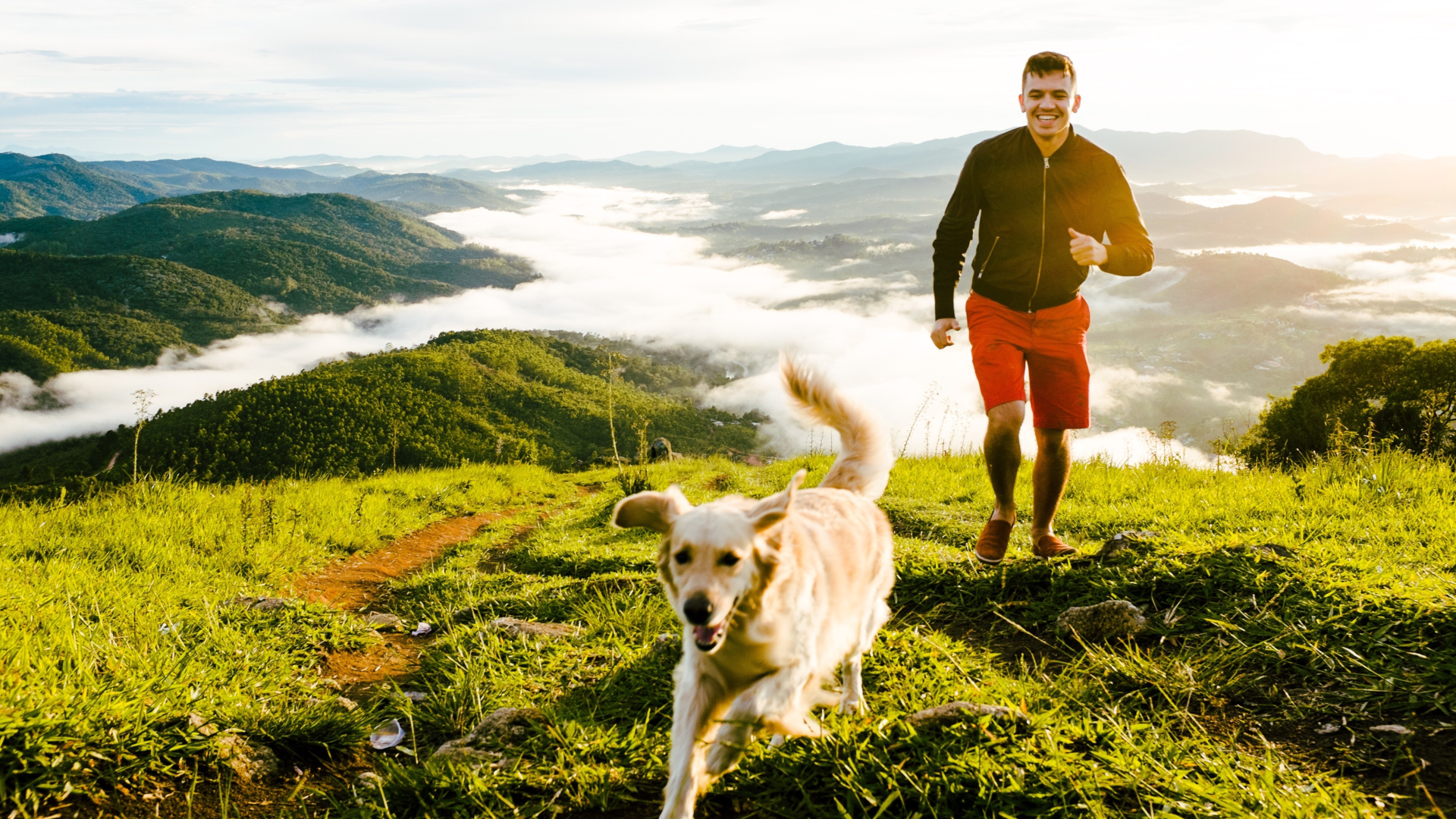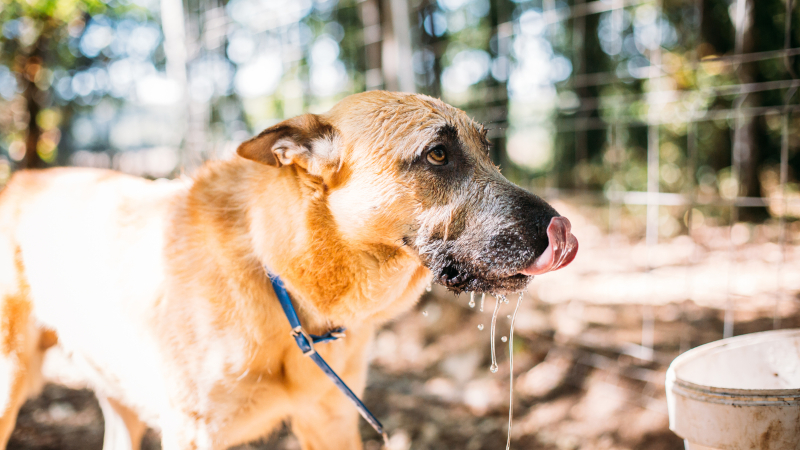How hot is too hot to take your dog hiking?
We discuss when it becomes too hot to safely take your dog on a hike, and 9 tips for keeping them safe in the summer

With warm temperatures showing no imminent signs of abating, we’ve given over plenty of time to explain how to hike in hot weather safely. Carry extra water, wear a hat and breathable layers, know the signs of heatstroke. Hikers frequently succumb to heat-related illnesses on the trail, but they’re not the only ones at risk – if you like to go hiking with your dog, you’ll need to be extra cautious when hot weather hits.
Dogs being left in hot cars usually make the headlines, but according to a 2020 study, the most common cause of heatstroke in dogs is being exercised by their owners. Unlike you, your dog cannot cool itself down by sweating, and panting isn’t as efficient, so your four-legged friend is much more susceptible to heat-related illnesses. Clearly, when you add an activity like hiking to heat, you raise the risk level because the strenuous activity will tire them out and dehydrate them further, so you need to take extra care.
Of course, if you live somewhere with consistently hot summers, you own a dog and you love hiking, there are times when you’re going to take your dog out into the wild, but you need to do so with caution. Read on to learn how hot is too hot to take your dog hiking, and how to keep them safe on the trails this summer.

How hot is too hot for a dog?
In general, vets agree that you need to start taking care when outside temperatures reach 68°F (19°C). Once temperatures surpass that temperature, your dog may be at risk of overheating, and certain dogs are more vulnerable. According to Vets Now, the most vulnerable dogs are those that are large or flat-faced breeds as well as very young and overweight dogs.
Once the mercury rises to 82°F (28°C), it can be life-threatening for those vulnerable dogs, and dangerous for all dogs, and at 89°F (32°C), all dogs are at risk of developing heatstroke regardless of age, condition or breed.
On very hot days, it’s best to leave them at home, but if you’re taking them with you in the summer, the following are some tips to keep your furry friend safe.
9 tips for hiking with your dog in hot weather
1. Check the weather
Before heading out, check the weather for the area and times you’ll be hiking and make sure the temperatures aren’t going into the danger zone. Be willing to make a game time decision and wait for another day if it’s going to be warmer than you anticipated.
All the latest inspiration, tips and guides to help you plan your next Advnture!

2. Brush your dog’s fur
Wearing a fur coat in the summer sounds like hell to us humans, but hopefully you know your dog’s coat is designed to keep them cool in hot weather as well as insulate them in the cold, so you should never shave it. That said, regular brushing can help to thin it out and vets agree this may be helpful in the warm months, so give them a good brush before you head out.
3. Go early
If you’ve decided it’s safe to take your dog on a hike, it’s important to leave early and avoid the hottest part of the day, usually between 11 a.m. and 3 p.m. Fortunately, the sun rises earlier in the summer, so if you get on the trail around 6 a.m. you may not even need a headlamp, and you’ve still got five hours of walking time ahead of you.
4. Seek a shaded trail
Especially if the day is forecast to be sunny, you’ll want to avoid leading your dog up an exposed mountain or on a coastal walk where there’s no shade. Look for forested trails with a thick canopy and lots of opportunity to rest in the shade.

5. Find a trail with a water source
A trail that affords lots of opportunities for your dog to drink and swim is really ideal. Find one that winds along a river or ends at a lake or pond where your dog can splash around and cool off.
6. Don’t go too far
Remember that if you’re hiking on an out-and-back trail, however far you walk, you have to walk again on the return, and it’s bound to get warmer as the day goes on. Your dog will probably love all the smells, soft ground and exercise, but it’s your job not to get too ambitious in warm weather. Don't set your sights on completing a 10-mile loop or reaching a summit just so you can get your workout in. Plan on a shorter hike and be willing to turn back early if you need to.
7. Carry a lot of water and a bowl
No matter how much water you’re expecting on the trail, you should carry a lot of water when hiking with your dog, as well as a collapsible bowl. As a good rule of thumb, pack more than you think you need. You might fill your hydration bladder for yourself, then carry two extra water bottles for your dog that are easier to pour from. Some doggie water bottles come with a bowl attached, or you can clip a soft collapsible bowl to your dog’s collar or your backpack. Take frequent breaks to drink water.

8. Bring booties or carry your dog over tarmac
If you’re sticking to dirt trails, you can skip over this one, but if you’re likely to encounter any paved surfaces – either getting to the trailhead or on the trail itself – your dog’s paw’s could be at danger of blistering and injury as these surfaces get red hot in the sunlight. Carry booties for your dog to wear during these sections, or if your dog is smaller, carry it over the tarmac.
9. Pay attention
Finally, the most important thing you can do is pay attention to your dog’s behavior. Don’t wear headphones or get too busy chatting to a friend that you miss the signs that your dog is overheating. Dogs can go for miles without exhibiting any signs of discomfort, so you need to know your dog well and understand when they might be struggling on to try to please you.
According to the RSPCA, the following are warning signs of heatstroke in your dog:
- Heavy panting
- Difficulty breathing
- Excessively drooling
- The dog appears lethargic, drowsy or uncoordinated
- Collapsed or vomiting
If you observe any of these signs, immediately get your dog to the vet.
Julia Clarke is a staff writer for Advnture.com and the author of the book Restorative Yoga for Beginners. She loves to explore mountains on foot, bike, skis and belay and then recover on the the yoga mat. Julia graduated with a degree in journalism in 2004 and spent eight years working as a radio presenter in Kansas City, Vermont, Boston and New York City before discovering the joys of the Rocky Mountains. She then detoured west to Colorado and enjoyed 11 years teaching yoga in Vail before returning to her hometown of Glasgow, Scotland in 2020 to focus on family and writing.

